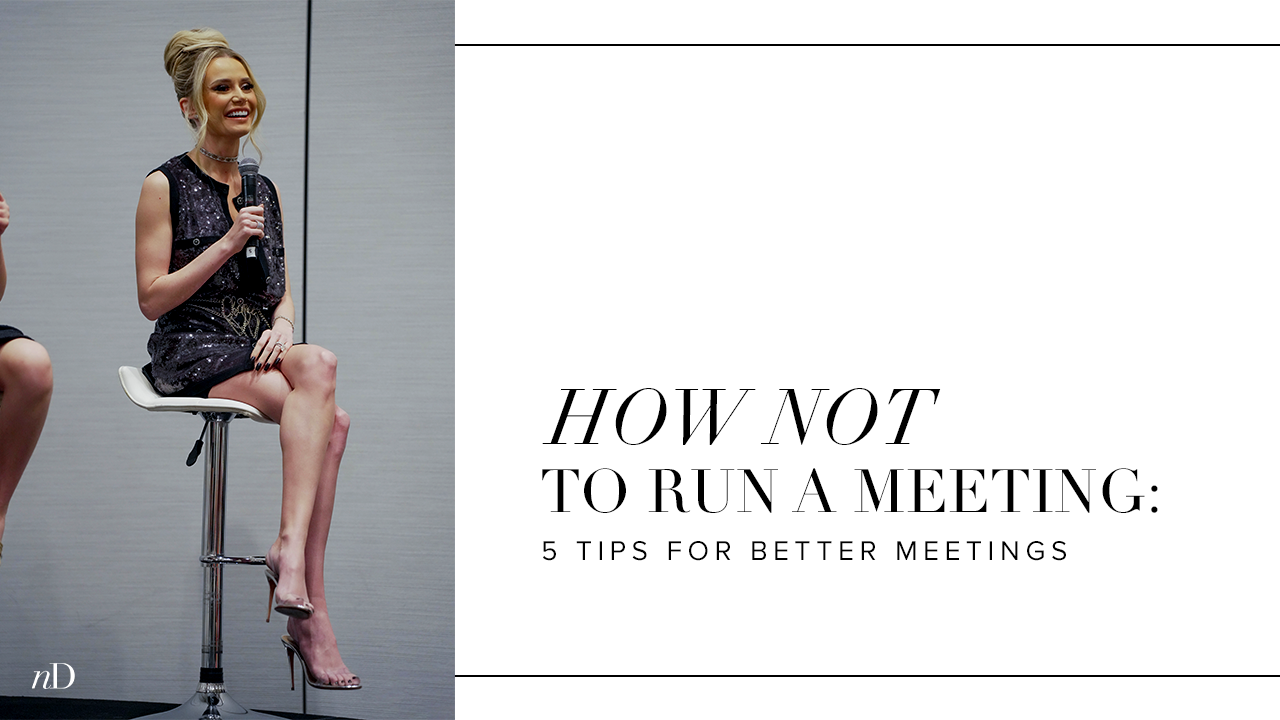Ineffective meetings lead to ineffective businesses
Have you ever sat through a meeting that you absolutely, 100% did not need to be in? Same, and, I bet you’ll agree with me that it’s not fun. In fact, it’s quite the opposite of fun. It can be an incredible waste of time and valuable mental space that could be spent doing my job or pushing toward my goals.
Now, have you ever been in a meeting that you did need to attend but was so poorly run that you didn’t get through your agenda or didn’t accomplish anything? Same, and this is, in my opinion, even more of a headache than sitting through a meeting you weren’t needed in.
I think a lot of the reason why this happens is because meeting hosts genuinely don’t know what they’re doing wrong. Luckily, running effective meetings is a learnable skill, and it’s a topic I’m excited to teach more over the coming months.
What to do in a meeting and what not to do in a meeting are two completely different topics, in my opinion, so maybe I’ll write another post about how to lead an effective meeting later. But, today, let’s talk about the 5 things not to do in a meeting.

1. Don’t ask for anyone and everyone’s opinions
I’ve sat in on a few meetings recently where the individual running the meeting will present an idea and ask for everyone’s opinion. This is fine if you’re using this time as a creative brainstorm to problem-solve a roadblock or gather ideas before you execute a project. But, where this becomes a problem is when you’re soliciting advice from people who have no business giving advice in this situation.
The issue with this particular meeting was that the group did not have the experience — or “stats,” as I like to say — to be giving advice, and so the meeting went off on an unnecessary and unproductive tangent where everyone was sharing opinions and couldn’t reach a resolution.
In general, but especially in meetings, if you need advice or guidance on something, make sure you’re asking the right people with the right stats to back up their opinion. Your peers won’t be able to offer any perspective that you don’t already have unless they are experienced in the subject.
2. Never — and I mean never — talk about employee issues in a group setting
I can’t think of a single situation where it would be necessary for a group of peers or leaders to discuss an employee issue. Doing this sets the precedent for the group that this is okay in your company culture, and will lead to every person in the group wondering, “Geeze, I wonder if people are talking about me in groups behind my back, too?”
Instead, this conversation needs to happen in a 1:1 meeting, if you’re having an issue with your direct report, or the situation needs to be brought to the person’s manager, who can then provide feedback and work toward a solution.
Crowdsourcing a problem with any employee of any level of your organization is absolutely unnecessary.
3. Don’t be indecisive
There are few things worse than wasting a whole hour-long meeting talking about an issue and leaving the meeting with no decision or resolution. What was the point, then?!
If you’re a decision maker, or your team is asking you for advice or opinions, just make a decision. You will always have the opportunity to pivot or adjust down the road, but, by being indecisive or beating around the bush of a decision, you’re slowing down the momentum of your business.
No one wants to be around an indecisive person, let alone report to that person or allow them to be the guiding voice in the business. Something that Brandon and Grant do really effectively is they can make a fast decision with the minimum viable amount of information. In other words, they don’t want any fluff, they just want what’s necessary to make a somewhat educated decision and allow themselves to pivot later.

4. Don’t invite the wrong people to the meeting
I thought this was a pretty standard practice up until the last few days, but be really intentional about who is coming to meetings. This means don’t invite people that can’t contribute in a meaningful way and don’t involve people in problem-solving that shouldn’t be dealing with that problem. We call that “putting problems on people’s lines,” or, in other words, don’t bother someone with an issue that should be worrying about other things.
For example, when we were first starting Cardone Ventures and developing our first product offering, we didn’t involve our head of sales in any discussions about the inevitable problems that come with rolling out a new product. We didn’t need him going into sales meetings thinking that some objections may be valid and there was no use handling them.
This applies across departments, too. Some information is just unnecessary for certain departments, and the additional context will take up valuable mental space for those people to do their jobs. Only involve the people who truly need to be there. Less is more when it comes to meetings!
5. Don’t be disorganized, but also don’t over prepare
A meeting without a thoughtful agenda is doomed to failure from the start. There needs to be an agenda of topics to discuss, decisions to make, and problems to solve. If you’re showing up to a meeting without an agenda, you’ll probably end up wasting everyone’s time or forgetting actual things you need to discuss.
But, there is such a thing as being too organized or too prepared for a meeting. Meetings are always going to stray from an agenda a little bit, so overpreparation can be a waste of time, in my opinion. Come with your topics, open the floor to last-minute additions, and let it flow from there.
–
I am incredibly passionate about meetings — even though most people would say that’s such a boring thing to be passionate about — and I have lots of great content planned over the coming months to help business leaders make the most of meetings.
If you’re interested in more tips for how to be an effective leader or manager, check out the Building Billions podcast where I talk about all things business and share practical tips. Can’t wait to see you there!

